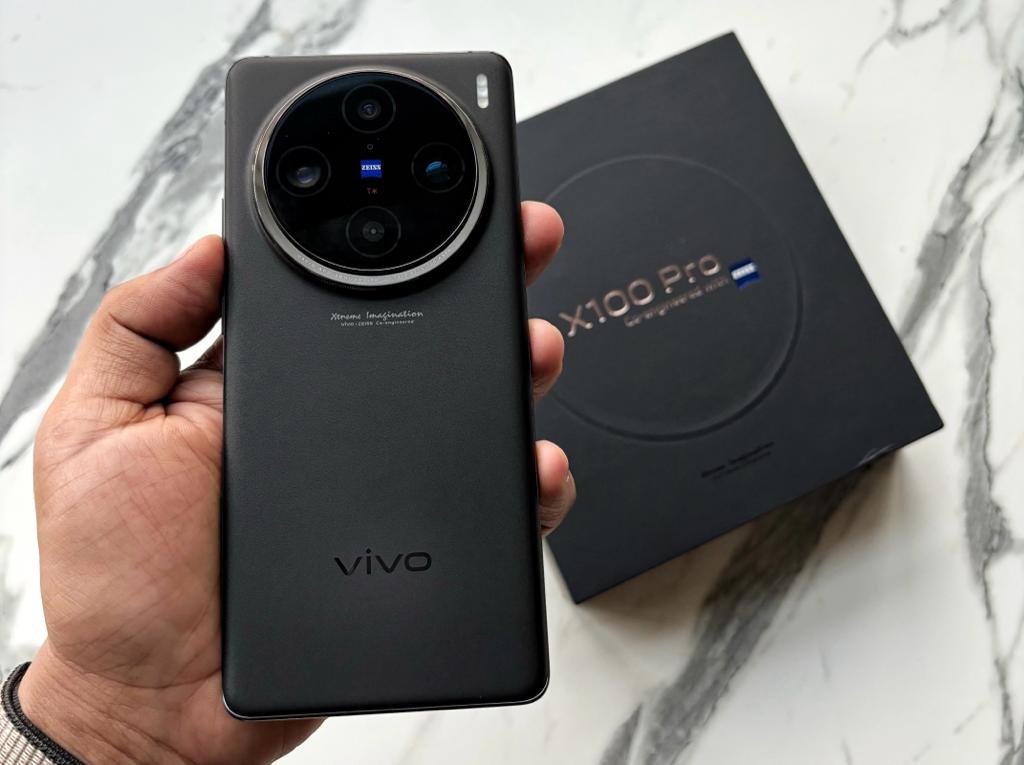Vivo’s most recent top-of-the-line smartphone, the X100 Pro, has generated a lot of buzz with its triple 50MP camera system and modern specifications. However, with so many smartphones available on the market, does it truly distinguish itself from the rest? Let’s take a deep dive into a thorough review to find out.
CAMERA
Without a doubt, the highlight of the X100 Pro is its camera. The back of the phone has three camera sensors, all of which are 50MP sensors (main, wide, telephoto) that shine in their own way. The Main camera has the Sony IMX989 sensor, which captures stunningly detailed photos with accurate colours and excellent dynamic range. Low-light performance is commendable, thanks to effective noise reduction. The Wide lens captures expansive landscapes or group shots into the frame. However, slight sharpness and colour fringing issues are noticeable. Then comes the Telephoto lens, which offers an impressive 5x optical zoom for close-up shots with minimal loss of detail. In photo mode, the zoom can go up to 60x, where the photo looks grainy but readable.
The Vivo software adds Gimbal Stabilization, further polishing the photography experience. The Astro Mode features the AR Planetarium, a fun addition for astronomy enthusiasts.
However, the X100 Pro has some camera quirks. The ultrawide lens could benefit from better sharpness, and the zoom capability doesn’t quite match the best in the market (like the Samsung Galaxy S23 Ultra). Additionally, while AI processing generally enhances photos, it can sometimes lead to oversaturated colours.
With impressive clarity and stability, the phone can record 8K videos at 30fps and 4K videos at 60fps.
The front camera of the Vivo x100 pro is a 32MP sensor that can take decent selfies, but it is not as impressive as the rear cameras. The selfies tend to look soft and overexposed, and the portrait mode could be more accurate. The front camera can also record 4K videos at 30fps, but the quality could be more impressive.
DESIGN
The X100 Pro stuns with its sleek, curved design and premium materials. The matte glass back features a fluorite anti-glare coating and a Circular camera module, a familiar Vivo X series design. The phone is quite heavy at 225 grams and thick at 8.91mm, but it feels solid and premium in the hand. The phone also has an IP68 dust and water resistance rating, a plus point.
DISPLAY
The phone features a large 6.78-inch LTPO AMOLED display with an impressive 120Hz refresh rate. The display is sharp, vibrant, and responsive, offering excellent viewing angles and colour accuracy. It supports HDR10 and HDR10+ but not Dolby Vision. However, the screen has some curvature on the sides, which may cause accidental touches. Nevertheless, it also enhances the immersive viewing experience.
PERFORMANCE
The Vivo x100 Pro has the powerful MediaTek Dimensity 9300 chipset, a 5G-enabled processor that can compete with the Snapdragon 8 Gen 3 chipset. With 16GB of RAM and 512GB of internal storage, the phone can easily handle multitasking and store media files. Thanks to its liquid cooling system that prevents overheating and throttling, it provides a smooth and lag-free experience while running any task or game.
The Vivo x100 Pro runs on Android 12 with Funtouch OS 12 on top, which offers a user-friendly and smooth software experience. It has useful features like the Ultra Game Mode, the Smart Split Screen and the Always-on Display. Although the software has some bloatware and ads, which can be irritating, they can be easily deleted with some effort. The phone also has an in-display fingerprint scanner and face unlock that is quick and reliable.
BATTERY LIFE
The Vivo X100 Pro has a 5,000mAh battery that can easily last a full day, even with moderate to heavy usage. Additionally, the phone supports 120W fast charging, which means it can be charged from 0 to 100 percent in just 15 minutes. Unfortunately, the phone doesn’t support wireless charging or reverse wireless charging, which can be a drawback given its price.
VERDICT
The Vivo X100 Pro is undeniably a high-end smartphone with a phenomenal camera system, making it a value-for-money smartphone. Its camera is the phone’s main selling point, and it excels in this department, possessing a versatile and powerful rear camera system that can rival the best in the market. Additionally, the phone has a stunning curved display, fast and smooth performance, and long-lasting battery life with super-fast charging. However, it has some drawbacks, such as the underwhelming selfie camera and unwanted apps/games, but they are not deal-breakers. If you’re looking for a phone that will make you believe in your photography skills, the Vivo X100 Pro is definitely worth considering.
